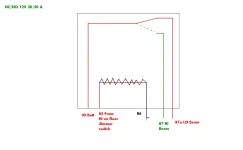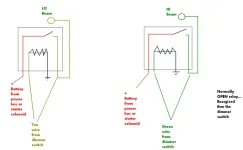Like I wrote on the first page...
"WOW! Are you in for an unpleasant surprise!"
Some more bad news...
And the guys that installed the same harness, did NO testing will argue this, but here are the FACTS.
I don't believe in a 'Sliding Scale' to see what you can get away with,
Either it's 'Safe' or it's 'Fail-Safe' and there isn't a 'Gray' area in the way I do things...
Just because "99% Can Get Away With This Or That",
DOES NOT MEAN IT'S RIGHT, CORRECT, or 'SAFE ENOUGH'...
-----------------
Power IN,
The master power to the fuse block needs some sort of 'Fuse' to protect the WIRE from battery to fuse block.
In a stock harness, that's a FUSIBLE LINK at the starter relay connection.
With Painful, that's usually a 'Maxi Fuse'.
Now, fusible links were installed from the factory,
And unless you do something stupid, like ground out the 'BAT' terminal on the alternator or rub/pinch through the master power wire to the fuse block they worked 30 or 40 years without fail...
Since they were SEALED UP with the rest of the wiring harness.
The 'Maxi-Fuse' sockets are usually NOT sealed.
They are a magnet/catch basin for everything that flies around the engine bay, spray from tires, whatever runs down the wire into the socket, ect.
I find corrosion in EVERY maxi fuse socket I've had to deal with...
And the 'Fuse'/wire protection MUST go out there on the fender, as close to the starter relay as is practical to protect the WIRE going to the fuse block.
So no hiding it someplace less exposed...
-----------------------------
REMEMBER!
The 'FEED' to the head lights AND the fuse block is only 10 Ga.,
See the Brown & Sharp scale posted.
When the headlights alone can draw 30 Amps,
AND,
All the gauges, other lights, and everything else is drawing off that 10 Ga. feed through the fuse block which can only
SAFELY support 32.5 Amps...
And,
You are considering HIGHER DRAW HEADLIGHTS...
----------------------------
NOW...
Painful *Usually* puts in fuses that are WAY TOO BIG for the wire they are *SUPPOSED TO PROTECT*...
That's why I often recommend you REWIRE your old fuse block yourself,
Just install new wires on the old fuse block,
Or swap in something with NEWER type fuses instead of going 'Painful' or some other pre-made fuse block.
Remember, Fuses protect the WIRE to the electrical device...
If that wire gets
DEAD 'Shorted' to 'Ground', the wire is going to try to burn INSTANTLY...
And the fuse will usually protect the wire, but too late, the insulation will melt and the wire will be damaged beyond use...
But if that wire gets PINCHED, or rubbed through,
The 'Short' might NOT be total (Dead Grounded),
And the wire heats up SLOWLY, the fuse doesn't blow and you get a fire...
The WIRE should always be of larger current capacity than the fuse.
That's why I posted the Brown & Sharp wire gauge/capacity chart...
COLUMN 1, WIRE GAUGE SIZE, COLUMN 4 AMP LOAD CAPACITY
Notice say, a 12 ga. wire will conduct 23 Amps without heating up.
Your head lights usually have a 25 to 30 Amp fuse on a 12 Ga. wire (or smaller) and this is simply NO GOOD!
If the 12 Ga. wire will conduct 23 amps, then you should use no larger than a 20 Amp fuse TO PROTECT THE WIRE.
If a 10 ga. wire will conduct 32.5 Amps, then you shouldn't use anything larger than a 30 Amp fuse TO PROTECT THE WIRE.
-------------
The 'Factory' did testing, they found that they could SLIGHTLY heat the wire during 100 duty cycle and get away with it,
And that became the new 'Standard'...
For a PARTICULAR INSULATION.
Since this isn't 'Factory' wire, we don't have any idea what insulation is on it, or what it's melt/burn point is...
Some things you shouldn't mess with...
Like burning your vehicle down in the garage at 3AM when everyone is asleep...
-------------------
DEAD SAFE/'FAIL SAFE'!
THE FUSE SHOULD BLOW BEFORE THE WIRE HEATS UP!
Check the OUTBOUND wire gauges from the fuse block, and use the appropriate fuse for that WIRE SIZE.
No matter what 'Painful' or any of the other makers recommend...
And remember this,
The battery produces CURRENT.
Current can come through as Voltage or Amperage.
As Voltage decreases, AMPERAGE INCREASES.
As the battery runs down and can't produce VOLTAGE,
The AMPERAGE will increase.
AMPERAGE is what burns vehicles down.
That's why 'Fuses' are rated in AMPS.
--------------------------
I'm using headlights here because the headlights are the largest draw outside of the starter motor or winch...
Now, there
IS a solution to things like headlights that will draw 20 to 30 Amps at 100% duty cycle.
And that's STOCK headlights. If you use higher output lights, the amperage to make that extra light INCREASES DEMAND.
TESTING the amperage draw of your headlights is a good idea,
See if the wiring provided is up to the task.
All it takes is an amp gauge and a little time...
Simply HOT WIRE one or both of your headlights with a supply, a 'Ground Path' and an amp gauge in the supply line...
*IF* your chosen headlights DO NOT exceed the AMP CAPACITY of the wire used to supply them,
Then you are fine running the supply through the switch/provided wire.
If you EXCEED the amp load capacity of the wire gauge used, then it's time to do something about it...
If your headlights demand more amperage, voltage drops on the line to the head lights or the amp gauge shows more draw than the supply wire can SAFELY handle,
Then there is a solution...
That solution is head light relays.
A FUSED direct feed from battery supply to the headlights that is controlled by the head light switch.
LARGE, FUSED wires to the relays/headlights,
Small wires from switch activate the relays.
No fuss, no screw ups, FAIL SAFE built in.
And, it's pretty easy to do without buying one of those headlight wiring packages that *May* or *May Not* have 'Correct' wiring gauges/fusing when it gets to you...
----------
Taking the headlight draw OFF OF the master power to the fuse block is one of the single best things you can do for the feed to the rest of your lights, gauges, ect.
Headlights on relays do this extremely efficiently,
AND,
Headlight relays supply the headlights with the current they need to work at their peak efficiency.
It's a Win/Win for your headlights and UNDERSIZED/OVERWORKED wiring harness.

 is for the birds...
is for the birds...


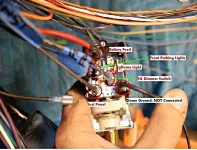
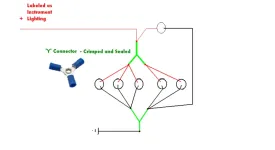
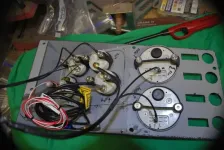
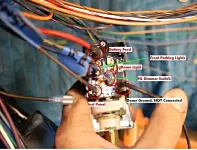
 ... they come on with 12V on the 'battery' post on the switch, both grounded (common post)... with the headlamp switch pulled out to the 1st detent
... they come on with 12V on the 'battery' post on the switch, both grounded (common post)... with the headlamp switch pulled out to the 1st detent
